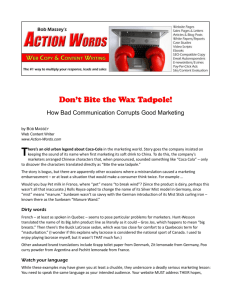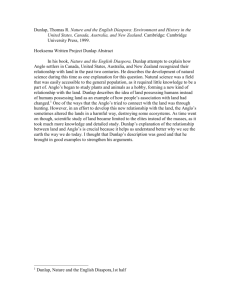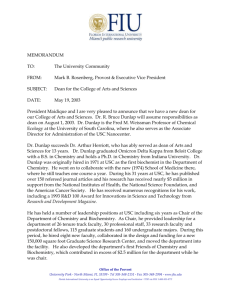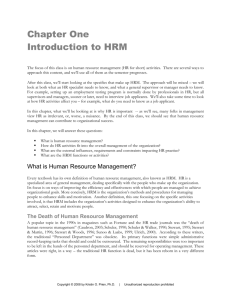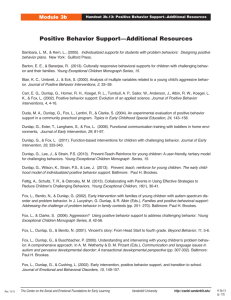Sunbeam Corporation: “Chainsaw Al,” Greed, and Recovery
advertisement
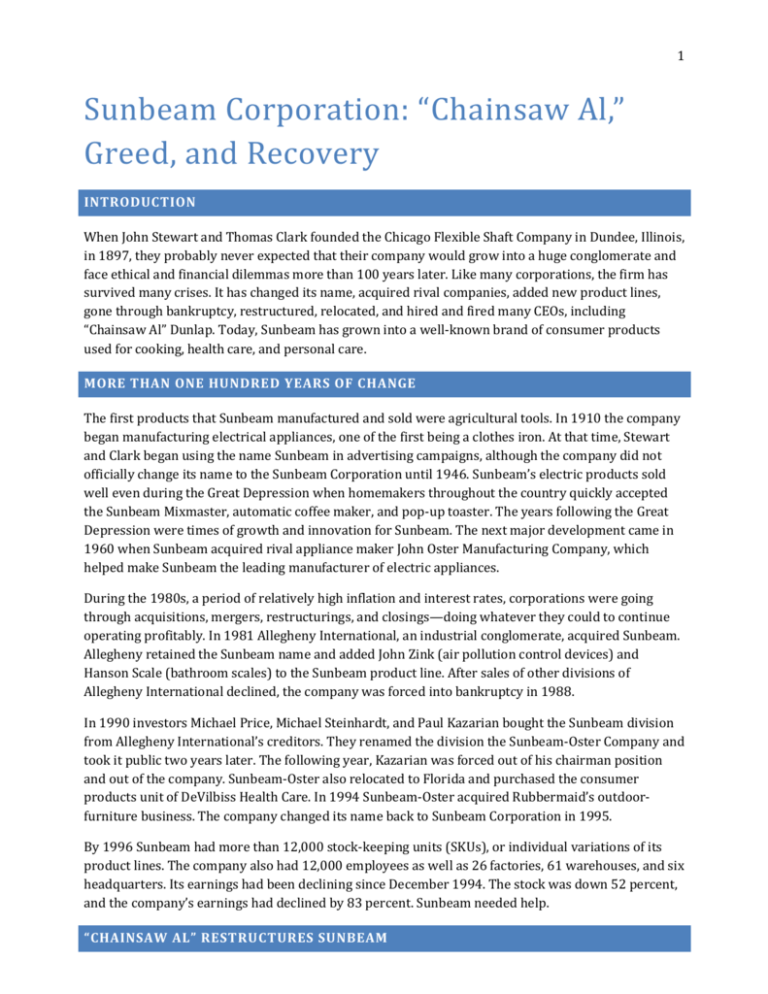
1 Sunbeam Corporation: “Chainsaw Al,” Greed, and Recovery INTRODUCTION When John Stewart and Thomas Clark founded the Chicago Flexible Shaft Company in Dundee, Illinois, in 1897, they probably never expected that their company would grow into a huge conglomerate and face ethical and financial dilemmas more than 100 years later. Like many corporations, the firm has survived many crises. It has changed its name, acquired rival companies, added new product lines, gone through bankruptcy, restructured, relocated, and hired and fired many CEOs, including “Chainsaw Al” Dunlap. Today, Sunbeam has grown into a well-known brand of consumer products used for cooking, health care, and personal care. MORE THAN ONE HUNDRED YEARS OF CHANGE The first products that Sunbeam manufactured and sold were agricultural tools. In 1910 the company began manufacturing electrical appliances, one of the first being a clothes iron. At that time, Stewart and Clark began using the name Sunbeam in advertising campaigns, although the company did not officially change its name to the Sunbeam Corporation until 1946. Sunbeam’s electric products sold well even during the Great Depression when homemakers throughout the country quickly accepted the Sunbeam Mixmaster, automatic coffee maker, and pop-up toaster. The years following the Great Depression were times of growth and innovation for Sunbeam. The next major development came in 1960 when Sunbeam acquired rival appliance maker John Oster Manufacturing Company, which helped make Sunbeam the leading manufacturer of electric appliances. During the 1980s, a period of relatively high inflation and interest rates, corporations were going through acquisitions, mergers, restructurings, and closings—doing whatever they could to continue operating profitably. In 1981 Allegheny International, an industrial conglomerate, acquired Sunbeam. Allegheny retained the Sunbeam name and added John Zink (air pollution control devices) and Hanson Scale (bathroom scales) to the Sunbeam product line. After sales of other divisions of Allegheny International declined, the company was forced into bankruptcy in 1988. In 1990 investors Michael Price, Michael Steinhardt, and Paul Kazarian bought the Sunbeam division from Allegheny International’s creditors. They renamed the division the Sunbeam-Oster Company and took it public two years later. The following year, Kazarian was forced out of his chairman position and out of the company. Sunbeam-Oster also relocated to Florida and purchased the consumer products unit of DeVilbiss Health Care. In 1994 Sunbeam-Oster acquired Rubbermaid’s outdoorfurniture business. The company changed its name back to Sunbeam Corporation in 1995. By 1996 Sunbeam had more than 12,000 stock-keeping units (SKUs), or individual variations of its product lines. The company also had 12,000 employees as well as 26 factories, 61 warehouses, and six headquarters. Its earnings had been declining since December 1994. The stock was down 52 percent, and the company’s earnings had declined by 83 percent. Sunbeam needed help. “CHAINSAW AL” RESTRUCTURES SUNBEAM 2 Michael Price and Michael Steinhardt hired Al Dunlap as the CEO and chairman of the board for Sunbeam Corporation in July 1996. Price and Steinhardt had tried to sell Sunbeam but were unsuccessful. They decided to see if Dunlap could save Sunbeam, although they knew he had a reputation for extensive layoffs and huge operating cuts. They believed, however, that such drastic efforts were necessary to turn Sunbeam around and increase stock prices and profits. Before taking the reins at Sunbeam, Dunlap had acquired a reputation as one of the country’s toughest executives—as well as nicknames like “Chainsaw Al,” “Rambo in Pinstripes,” and “The Shredder”— because he eliminated thousands of jobs while restructuring financially troubled companies. His reputation and business philosophy were recognized throughout the world. His operating philosophy was to make extreme cuts in all areas of operations, including extensive layoffs, in order to streamline a business and return it to profitability Later in his career, Dunlap authored a book outlining his strategy, entitled Mean Business, in which he stressed that the most important goal of any business is to make money for shareholders. To achieve this goal, Dunlap developed four simple rules of business: (1) Get the right management team, (2) cut back to the lowest costs, (3) focus on the core business, and (4) get a real strategy. By following those four rules, Dunlap claims that he helped turn around companies in 17 states and across three continents. Sunbeam’s stock price increased 49 percent on the day Dunlap was named chairman and CEO. The rise from $12.12 to $18.58 added $500 million to Sunbeam’s market value. The stock continued to increase, reaching a record high of $52 per share in March 1998. Although Dunlap’s acceptance of the helm at Sunbeam helped boost the company’s stock, he realized that his reputation alone would not hold the stock price up and that he needed to start the process of turning Sunbeam around. STEP 1: GET THE RIGHT MANAGEMENT TEAM In accordance with his management rules, Dunlap’s first move at Sunbeam was to change the management team. He retained only one senior executive from Sunbeam’s old management team. Dunlap’s first hire was Russ Kersh, a former employee of Dunlap, as executive vice president of finance and administration. The new management team also included 25 people who had previously worked for Dunlap at various companies. Dunlap believed in hiring these people because they had all worked with him and had been successful in past turnarounds. Dunlap and his “Dream Team for Sunbeam” quickly went into action implementing his second rule: Cut back to the lowest costs. STEP 2: CUT BACK In his book Mean Business, Dunlap writes, “Sunbeam’s employees wanted a leader and knew things had to change. Employees want stability. Restructuring actually brings stability, because the future is more clear.” However, Sunbeam’s employees also knew of Dunlap’s reputation for slashing jobs, which left many employees feeling threatened and insecure. As expected, after less than four months as chairman and CEO of Sunbeam, Dunlap announced plans to eliminate half of Sunbeam’s 12,000 employees worldwide. The layoffs affected all levels at Sunbeam. Management and clerical staff positions were cut from 1,529 to 697, and headquarters staff were cut by 60 percent, from 308 to 123 employees. On hearing of Dunlap’s layoff plans, U.S. Labor Secretary Robert Reich reportedly remarked, “There is no excuse for treating employees as if they are 3 disposable pieces of equipment.” Around the same time, the company’s share prices rose to the mid$20 range, and one of the original investors, Michael Steinhardt, sold his shares and divested himself of his Sunbeam connection altogether. Another method used by Dunlap to eliminate costs was to reduce the number of SKUs from 12,000 to 1,500. When Dunlap took over, Sunbeam had 36 variations of styles and colors for just one clothes iron. Such variation allows for product differentiation, a common business strategy, but so many variations of a consumer product can also be expensive to maintain. Instead of many product variations, Dunlap pursued service as the area to differentiate Sunbeam from competitors in the appliance business. Eliminating 10,500 SKUs also enabled Dunlap to close a number of factories and warehouses— another cost-saving method. He disposed of 18 factories worldwide and reduced the number of warehouses from 61 to 18. The layoff of thousands of employees, coupled with the reduction of SKUs, factories, and warehouses meant that fewer headquarter locations would be needed. Thus, Dunlap consolidated Sunbeam’s six headquarters into one facility in Delray Beach, Florida—Dunlap’s primary residence. STEP 3: FOCUS ON CORE BUSINESS Once the cost-cutting strategies had been implemented, Dunlap began to focus on Sunbeam’s core business. Dunlap and his Dream Team defined Sunbeam’s core business as electric appliances and appliance-related businesses. They identified five categories surrounding the core business as vital to Sunbeam’s success: kitchen appliances, health and home, outdoor cooking, personal care and comfort, and professional products. Any product that did not fit into one of the five categories was sold. Dunlap applied a simple criterion to decide whether to keep or divest a product line. Because he believed firmly that consumers recalled the Sunbeam brand name fondly, he retained any product that related to the Sunbeam brand name. STEP 4: GET A REAL STRATEGY Dunlap and his team defined Sunbeam’s strategy as driving the growth of the company through core business expansions by further differentiating Sunbeam’s products from competitors’, moving into new global markets, and introducing new products that were linked directly to emerging customer trends as lifestyles evolved around the world. As the first step in implementing this strategy, the company reengineered electrical appliances to 220 volts so they could be marketed and used internationally. Another step was reclaiming the differentiation between the Oster and Sunbeam lines. Each was designed, packaged, and advertised to target different markets. The Sunbeam line of products was positioned as an affordable, middle-class brand while Oster products were positioned as upscale, higher-end brands and sold at completely different retailers than the Sunbeam lines. Early in 1997, Sunbeam opened ten factory-outlet stores to increase brand awareness, sales, and ultimately shareholder wealth. THE TURNAROUND OF SUNBEAM Dunlap made all these changes within seven months at Sunbeam. The stock rose to more than $48 per share, a 284 percent increase since July 1996. Just 15 months after accepting the position as chairman 4 and CEO, Dunlap issued a press release in October 1997 announcing that the turnaround of Sunbeam was complete and that Morgan Stanley of Stanley Dean Witter & Co. had been hired to find a buyer for Sunbeam. However, according to John A. Byrne in his book Chainsaw, “No one was the least bit interested.” Byrne also reported that Dunlap misled a journalist into reporting that Philips, a Dutch electronics giant, was interested in purchasing Sunbeam for over $50 per share but that Dunlap wanted $70. In March 1998, Dunlap announced plans to buy three consumer products companies. Sunbeam acquired majority shares of Coleman (camping gear), Signature Brands (Mr. Coffee), and First Alert (smoke and gas alarms). Two days after announcing the purchase of the three companies, Sunbeam’s stock closed at a record high of $52 a share. With the stock price at an all-time high and 1997 net income reported at $109.4 million, Sunbeam truly seemed to have turned around—at least on paper. At the time, Dunlap’s management philosophy seemed to underlie his success at Sunbeam. He streamlined the company and attained what he considered the most important goal of any business: to make money for shareholders. In February 1998, Sunbeam’s board of directors expressed satisfaction with Dunlap’s leadership and signed a three-year employment contract with him that included 3.75 million shares of stock. Dunlap publicly praised himself and his Dream Team for saving the failing corporation. He was so confident in the success of their mission at Sunbeam that he added a complete chapter to his book Mean Business titled, “Now There’s a Bright Idea. Lesson: Everything You’ve Read So Far About Restructuring Works. This Chapter Proves It—Again.” Dunlap also suggested that all CEOs and boards of directors should read his book and use him as a role model in running their companies. SUNBEAM’S ACCOUNTING PRACTICES RAISE QUESTIONS Although Sunbeam had recovered from its near failure, the company soon faced tough times again. The three corporate purchases that more than doubled Sunbeam’s size and helped push the company’s stock price to $52 also helped cause a second crisis for Sunbeam. Rumors began surfacing that these purchases had been made to disguise losses through write-offs. Paine Webber, Inc. analyst Andrew Shore had been following Sunbeam since the day Dunlap was hired. As an analyst, Shore’s job was to make educated guesses about investing clients’ money in stocks. Thus, he had been scrutinizing Sunbeam’s financial statements every quarter and considered Sunbeam’s reported levels of inventory for certain items to be unusual for the time of year. For example, he noted massive increases in the sales of electric blankets in the third quarter although they usually sell well in the fourth quarter. He also observed that sales of grills were high in the fourth quarter, which is an unusual time of year for grills to be sold, and noted that accounts receivable were high. On April 3, 1998, just hours before Sunbeam announced a first-quarter loss of $44.6 million, Shore downgraded his assessment of the stock. By the end of the day Sunbeam’s stock prices had fallen 25 percent. Shore’s observations were indeed cause for concern. In fact, Dunlap had been using a bill-and-hold strategy with retailers, which boosted Sunbeam’s revenue, at least on the balance sheet. A bill-andhold strategy entails selling products at large discounts to retailers and holding them in third-party warehouses to be delivered at a later date. By booking sales months ahead of the actual shipment or billing, Sunbeam was able to report higher revenues in the form of accounts receivable, which inflated 5 its quarterly earnings. The strategy essentially shifted sales from future quarters to the current one, and in 1997 the strategy helped Dunlap boost Sunbeam’s revenues by 18 percent. The bill-and-hold strategy is not illegal and follows the generally accepted accounting principles (GAAP) of financial reporting. Nevertheless, Sunbeam’s shareholders filed lawsuits, alleging that the company had made misleading statements about its finances and deceived them so they would buy Sunbeam’s artificially inflated stock. A class-action lawsuit was filed on April 23, 1998, naming both Sunbeam Corporation and CEO Albert Dunlap as defendants. The lawsuit alleged that Sunbeam and Dunlap had violated the Securities and Exchange Act of 1934 by misrepresenting and/or omitting material information concerning the business operations, sales, and sales trends of the company. The lawsuit also alleged that the motivation for artificially inflating the price of the common stock was to enable Sunbeam to complete millions of dollars of debt financing in order to acquire Coleman, First Alert, and Signature Brands. Sunbeam’s subsequent reporting of earnings significantly below the original estimate caused a huge drop in its stock. Dunlap continued to run Sunbeam and the newly purchased companies as if nothing had happened. On May 11, 1998, he tried to reassure 200 major investors and Wall Street analysts that the firstquarter loss would not be repeated and that Sunbeam would post increased earnings in the second quarter. That same day he announced another 5,100 layoffs at Sunbeam and the acquired companies, possibly in an attempt to gain back investor confidence and divert attention away from the losses and lawsuits. The tactic failed. The press continued to report on Sunbeam’s bill-and-hold strategy and the accounting practices that Dunlap had allegedly used to artificially inflate revenues and profits. DUNLAP’S REPUTATION BACKFIRES Dunlap called an impromptu board meeting to address the reported charges on June 9, 1998. A partner from Sunbeam’s outside auditors, Arthur Andersen LLP, assured the board that the company’s 1997 numbers were in compliance with accounting standards and firmly stood by Arthur Andersen’s audit of Sunbeam’s financial statements. Robert J. Gluck, the comptroller at Sunbeam, who was also present at the board meeting, did not counter the auditor’s statement. The meeting seemed to be going well until Dunlap was asked if the company would make its projected second-quarter earnings. His response that sales were soft was not what the board expected to hear. Dunlap also announced that he had a document in his briefcase outlining a settlement of his contract for his departure from Sunbeam. The document was never reviewed. However, Dunlap’s behavior made board members suspicious, which led to an in-depth review of Dunlap’s practices. The review took place during the next four days in the form of personal phone calls and interviews between board members and select employees—without Dunlap’s knowledge. A personal conversation with Sunbeam’s executive vice president, David Fannin, reportedly revealed that the 1998 second-quarter sales were considerably below Dunlap’s forecast and that the company was in crisis. Dunlap had forecast a small increase, but the numbers provided by Fannin indicated that Sunbeam could lose as much as $60 million that quarter. Outside the boardroom and away from Dunlap, Gluck (the comptroller) revealed that the company had tried to do things in accordance with GAAP, but alleged that everything had been pushed to the limit. These revelations led the board of directors to call an emergency meeting. On Saturday, June 13, 1998, the board of directors, along with Fannin and a pair of lawyers, discussed the informal findings. They 6 agreed that they had lost confidence in Dunlap and his ability to turn Sunbeam around. The board of directors unanimously agreed that Dunlap had to go and drafted a letter calling for his immediate departure. “Chainsaw Al” was told that same day, in a one-minute conference call, that he was the next person to be cut at Sunbeam. There were legal ramifications from Dunlap’s firing. In an interview on July 9, 1998, Dunlap stated that he intended to challenge Sunbeam’s efforts to deny him severance under his contract, although both Dunlap and Sunbeam agreed not to take legal action against each other for a period of six months. Dunlap claimed that his mission was aborted prematurely and that three days after receiving the board of director’s support he was fired without being given a reason. On March 15, 1999, Dunlap filed an arbitration claim against Sunbeam to recover $5.5 million in unpaid salary, $58,000 worth of accrued vacation, and $150,000 in benefits as well as to have his stock options re-priced at $7 a share. Additionally, he sued the company for dragging its feet in reimbursing him for more than $1.4 million in legal and accounting fees he had racked up defending himself in lawsuits that alleged securities fraud. Although the board made it clear that they had no intention of paying Dunlap any more money, a judge ruled in his favor in June 1999. In September 2002, Al Dunlap agreed to pay $500,000 to settle the SEC’s charges that he defrauded investors by inflating sales at Sunbeam so as to make the company more attractive to a prospective buyer. According to the SEC, Sunbeam’s accounting practices inflated the company’s income by $60 million in 1997, “contributing to the false picture of a rapid turnaround in Sunbeam’s financial performance.” In settling the charges, Dunlap did not admit or deny any wrongdoing and agreed never to work as an executive or director of a public corporation again. Dunlap’s chief financial officer, Russell Kersh, agreed to the same ban and paid $200,000 to settle the SEC’s suit. The month before, Dunlap paid $15 million to settle a class-action lawsuit brought by shareholders with similar allegations. SUNBEAM FACES MORE CHALLENGES Once again, Sunbeam faced the need to revitalize itself. It was again looking for a new CEO, its stock price had dropped to as low as $10 per share, shareholders had filed lawsuits, legal action regarding Dunlap’s firing was underway, the SEC was scrutinizing Sunbeam’s accounting practices, the audit committee of the board of directors was requiring Sunbeam to restate its audited financial statements for 1997 and possibly for 1996 and the first quarter of 1998, and creditors were demanding payment in full. It took auditors four months to unravel the accounting statements from Dunlap’s tenure, which were confirmed to be legal but inaccurate. The 1997 net income was restated from $109.4 million to $38.3 million. Shareholder confidence was at an all-time low. Less than two years after Dunlap was hired, Sunbeam again reorganized and brought in a new senior management team. Jerry W. Levin accepted the position of president and CEO. He outlined a new strategy for Sunbeam, focusing on growth through increased product quality and customer service. The plan was to decentralize operations while maintaining centralized support and organizing into three operating groups. Four of the eight plants that were scheduled to be closed under Dunlap’s management remained open to ensure consistency of supply. In a press release, Levin outlined his strategy for revitalizing Sunbeam: “Our goal is to increase accountability at the business unit level, and to give our employees the tools they need to build their businesses. We are shifting Sunbeam’s focus to increasing quality in products and customer service.” 7 In a letter to the shareholders at the beginning of 1999, Levin stated that Sunbeam had gone back to the basics and intensified its focus on its powerful family of brands. He also wrote that the lending banks had extended covenant relief and waivers of past defaults until April 10, 2000. The $1.7 billion credit agreement was extended until April 14, 2000, at which time Sunbeam hoped to have a definitive agreement extending the covenant relief and waivers for an additional year. Sunbeam was required to restate its audited accounting reports. At this point, CEO Levin still had confidence in Sunbeam’s ability to recover. A press release on May 10, 2000, stated that the first-quarter results showed that net sales had increased 3 percent to $539 million and that operating results had narrowed to a loss of $3 million. Levin stated, These results, though improved, are not indicative of the value we have created, and will continue to create for Sunbeam’s shareholders. Looking forward, we expect operating results to further improve as we execute our long-range strategy that focuses on consumeroriented new products. However, on January 25, 2001, Sunbeam announced that it had been notified by the New York Stock Exchange (NYSE) that the company was not in compliance with minimum listing criteria. As a result, the NYSE delisted the company’s common stock. This meant that the stock ceased to be traded. The bad news continued when Sunbeam announced on February 6, 2001, that it planned to reorganize under Chapter 11 of the U.S. Bankruptcy Code due to its $3.2 billion in debt, some of which accrued from Dunlap’s acquisitions. The company expected no interruption in production or distribution. Senior management committed themselves to remaining in place and leading Sunbeam throughout the bankruptcy process and beyond. Sunbeam emerged from Chapter 11 bankruptcy proceedings in December 2002 and changed its name to American Household Inc. Its former household products division became the subsidiary Sunbeam Products, Inc. SUNBEAM AND “CHAINSAW AL” TODAY In September 2004, the Jarden Corporation purchased American Household, Inc., making Sunbeam products part of its Jarden Consumer Solutions branch. Jarden owns several well-known brands of consumer products including Bionaire®, Crock-Pot®, FoodSaver®, Health o meter®, Holmes®, Mr.Coffee®, Oster®, Patton®, Rival®, Seal-a-Meal®, and VillaWare®. Although Sunbeam-Oster no longer exists as a company, the brands can still be found in many major stores. Jarden ranks as number 348 on the Fortune 500 list. Al Dunlap has not held a job since he left Sunbeam. Additionally, the New York Times discovered that Dunlap had engaged in similar accounting fraud 20 years earlier in a position that he never included in his resume. After inflating profits for Nitec Paper Company in 1976, auditors discovered that missing expenses, overstated inventory, and nonexistent sales were reported in the company’s books. Dunlap also had severe interpersonal issues within the company, with all of his senior management team threatening to quit if he remained in charge of Nitec. A legal battle between Dunlap and the company ensued, ending only when Nitec filed for bankruptcy. Dunlap never included his time at Nitec in his employment history. In 2009, Conde Nast Portfolio named Al Dunlap the sixth worst CEO of all time. 8 QUESTIONS 1. How did pressures for financial performance contribute to Sunbeam’s culture where quarterly sales were manipulated to influence investors? 2. What were Dunlap’s contributions to the financial and public relations embarrassments at Sunbeam that caused investors and the public to question Sunbeam’s integrity? 3. Identify ethical issues that Dunlap’s management team may have created by adopting a shortrun focus on financial performance. What lessons could be learned from the outcome? Sources “20 Worst CEOs of All Time,” CNBC, May 2009, http://www.cnbc.com/id/30502091 (accessed June 12, 2015). Floyd Norris, “The Incomplete Résumé: A Special Report,” July 16, 2001, http://www.nytimes.com/2001/07/16/business/incomplete-resume-special-report-executive-s-missing-years-papering-overpast.html?pagewanted=1 (accessed June 12, 2015). Alexander Law Firm, via http://defrauded.com/sunbeam.shtml (accessed September 13, 1998). “American Household, Inc.,” Hoover’s online, http://www.hoovers.com/co/capsule/4/0,2163,11414 ,00.html (accessed April 16, 2003). Douglas Bell, “Take Me to Your Leader,” The Globe and Mail, January 28, 2000, http://www.robmagazine.com/archive/2000ROBfebruary/html/idea_log.html (accessed June 12, 2015). Martha Brannigan and Ellen Joan Pollock, “Dunlap Offers Tears and a Defense,” Wall Street Journal, July 9, 1998, B1. John A. Byrne, “How Al Dunlap Self-Destructed,” BusinessWeek, July 6, 1998, 58–65. John A. Byrne, “The Notorious Career of Al Dunlap in the Era of Profit-at-Any-Price,” in Chainsaw (New York: HarperCollins, 1999). John A. Byrne, “Chainsaw Al Dunlap Cuts His Last Deal,” BusinessWeek online, September 5, 2002, http://www.businessweek.com/bwdaily/dnflash/sep2002/nf2002095_2847.htm (accessed June 12, 2015). Albert J. Dunlap and Bob Aldeman, “How I Save Bad Companies and Make Good Companies Great,” Mean Business, rev. ed. (New York: Simon & Schuster, 1997). “Dunlap and Kersh Resign from Sunbeam Board of Directors,” Company News On-Call, http://www.prnewswire.com (accessed September 13, 1998). Jarden Consumer Solutions website, http://www.jarden.com/ (accessed June 12, 2015). Daniel Kadlec, “Chainsaw Al Gets the Chop,” Time, June 29, 1998, http://content.time.com/time/magazine/article/0,9171,988628,00.html (accessed June 12, 2015). “Letter from CEO Jerry W. Levin,” Sunbeam, June 10, 2000, http://www.sunbeam.com (unknown access date). Steve Matthews, “Sunbeam’s Ex-CEO Seeks $5.25 Million in Arbitration Claim,” Bloomberg News, March 15, 1999. Andy Ostmeyer, “‘Chainsaw Al’ Agrees to Settle Suit,” Joplin [Missouri] Globe online, January 16, 2002, http://www.joplinglobe.com/archives/2002/020116/regional/story5.html (unknown access date). Andy Ostmeyer, “Sunbeam’s Bankruptcy Protection Plan OK’d,” Joplin [Missouri] Globe online, November 27, 2002, http://www.joplinglobe.com/archives/2002/021127/regional/story2.html (unknown access date). PR Newswire, “Sunbeam Announces Eastpak Sale Complete,” The Free Library, May 30, 2000, http://www.thefreelibrary.com/Sunbeam+Announces+Eastpak+Sale+Complete.-a062446415 (accessed June 12, 2015). PR Newswire, “Sunbeam Signs Memorandum of Understanding to Settle Coleman Shareholder Litigation,” The Free Library, October 21, 1998, http://www.prnewswire.com (accessed June 12, 2015). Neil Roland and Judy Mathewson, with Robert Schmidt, “Sunbeam Ex-CEO ‘Chainsaw Al’ Dunlap Settles SEC Case,” Bloomberg News, September 4, 2002. Matthew Schifrin, “Chainsaw Al to the Rescue,” Forbes online, August 26, 1996, http://www.forbes.com/forbes/082696/5805042a.htm (unknown access date). Matthew Schifrin, “The Unkindest Cuts,” Forbes online, May 4, 1998, http://www.forbes.com/forbes/1998/0504/6109044a.html (accessed June 12, 2015). Matthew Schifrin, “The Sunbeam Soap Opera: Chapter 6,” Forbes, July 6, 1998, 44–45. Patricia Sellers, “First: Sunbeam’s Investors Draw Their Knives—Exit for Chainsaw?” Fortune, June 8, 1998, 30– 31. “Sunbeam Balks at Dunlap’s Demand for $5.5 Million,” Naples [Florida] Daily News, March 17, 1999. “Sunbeam Completes Acquisition of Coleman Publicly Held Shares,” Sunbeam press release, January 6, 2000, http://www.sunbeam.com (unknown access date). “Sunbeam Corporation,” Hoover’s online, http://www.hoovers.com/premium/profiles/11414.html (accessed September 19, 1998). “Sunbeam Corporation Announces Plan to Reorganize under Chapter 11,” Sunbeam press release, February 6, 2001, http://www.sunbeam.com/media room/soc_reorg.htm (unknown access date). “Sunbeam Credit Waivers Extended to April 14, 2000,” PR Newswire, April 11, 2000, http://www.prnewswire.com (unknown access date). “Sunbeam Joins Microsoft in the Universal Plug and Play Forum to Establish a ‘Universal’ Smart Appliance Technology Standard,” Sunbeam press release, March 23, 2000, http://www.sunbeam.com (unknown access date). “Sunbeam Outlines New Strategy, Organizational Structure, Senior Management Team,” Company News On-Call, via http://www.prnewswire.com (accessed September 13, 1998). “Sunbeam Reports First Quarter 2000 Results,” Sunbeam press release, May 10, 2000, http://www.sunbeam.com (unknown access date). “Sunbeam to Restate Financial Results,” Company News On-Call, http://www.prnewswire.com (accessed September 13, 1998). “Time for Smart Talk Is Over,” Sunbeam press release, January 14, 2000, http://www.sunbeam.com (unknown access date). 9 “VF To Acquire Eastpak Brand,” Sunbeam press release, March 20, 2000, http://www.sunbeam.com (unknown access date).
